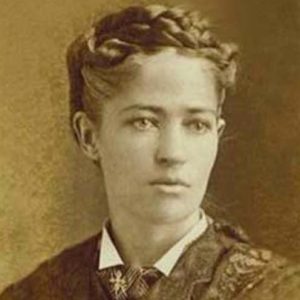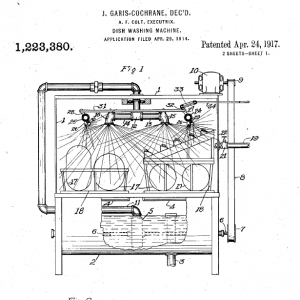
For this month’s Kickass Women in History we turn to the nerdy end of the spectrum with Josephine Cochrane (sometimes spelled ‘Cochran’). She was the inventor of the modern dishwasher.
Born 1839, Josephine Garis came from a nerdy family of engineers and inventors. In 1858 she married a wealthy man, William Cochran, who had earned a ridiculous amount of money as a dry goods merchant. When they married, Cochrane took her husband’s last name as was the custom, but she added an ‘e’ to the end of it.
After the marriage, Cochrane had two children (one of whom died at the age of two) and became a full-time socialite. The family lived in Shelbyville, Illinois. Cochrane liked to entertain with her special china and she hated it when the dishes were chipped, which she blamed on poor handling by the servants. She started washing her own dishes, and to her extreme annoyance she chipped some herself. Eventually, according to the U.S. Patent and Trade Office, she declared: “If nobody else is going to invent a [mechanical] dishwashing machine, I’ll do it myself.”

In 1883, Cochrane’s husband died. She was left with a small savings and her husband’s debt, and resolved to earn money by fine-tuning, patenting, and selling the dishwasher. She is quoted by the U.S. Patent and Trade Office as having said:
I couldn’t get men to do the things I wanted in my way until they had tried and failed on their own, and that was costly for me. They knew I knew nothing, academically, about mechanics, and they insisted on having their own way with my invention until they convinced themselves my way was the better, no matter how I had arrived at it.
Technically, Cochrane did NOT invent the first mechanical dishwasher. In 1850, Joel Houghton invented a wooden box with a hand-cranked wheel and scrubbers that would splash water onto dishes. This dishwasher was neither user-friendly nor popular.
What Cochrane invented was essentially the dishwasher we know and love today. The biggest breakthrough came when she decided to use water pressure to clean the dishes instead of scrubbers. IEEE Spectrum explains how it worked:
To make the machine wash dishes efficiently, Cochran measured the width, height, and length of plates, cups, and saucers and constructed wire compartments for the china to sit in. The compartments separated each piece of dishware. At the bottom of the machine was a container that held soap. The compartments were placed inside a wheel that laid flat within a copper boiler, according to the Lemelson-MIT program’s profile of Cochran. A motor powered the wheel, which turned as soapy water was squirted on the dishes to clean them.
Cochrane was awarded her patent in 1885, and, with the help of George Butters, a mechanic, created a functioning machine in time for the World Columbian Exposition of 1893. Her machine was the only invention at the event that was patented by a woman, and it won a prize of “best mechanical construction, durability, and adaptation to its line of work.”

Most early dishwashers were sold to hotels and restaurants, since they were too expensive for most families to buy. She ended up owning a factory that manufactured dishwashers. She spent the rest of her life adjusting the design. She owned the company and refused to step down despite pressure from investors, who wanted her to be replaced by a man. Cochrane found that running the company and promoting and selling washers was much more difficult than inventing them, as she was constantly pushed outside her comfort zone and doing business with men, as in this occasion:
[It was] almost the hardest thing I ever did, I think, crossing the great lobby of the Sherman House alone. You cannot imagine what it was like in those days…for a woman to cross a hotel lobby alone. I had never been anywhere without my husband or father—the lobby seemed a mile wide. I thought I should faint at every step, but I didn’t—and I got an $800 order as my reward.
Cochrane worked right up until her death at the age of 74, which some believe was from exhaustion. In 2006, she was inducted into the National Inventors Hall of Fame. It’s about time.


Great post. Thank you.
For the first time in my life I live in a house with a dishwasher and it is glorious! Thank you to Josephine Cochrane, and Carrie S for bringing her to my attention.
Thanks for sharing her story (which I knew but didn’t remember her name)! Being a woman is Hard Work!
Thanks, Carrie, for introducing me to a fascinating woman!
And did anyone else have an ironic moment when they realized the fight between partners over how to use the dishwasher began even before it was in production?